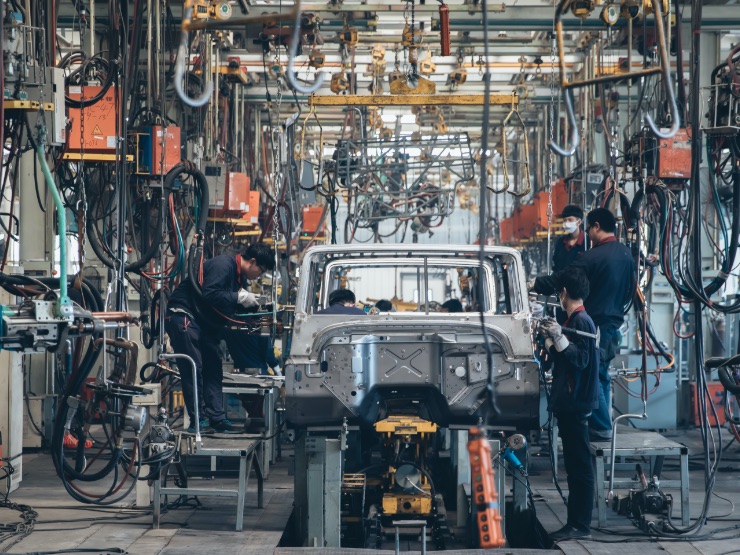-
Featured services
Harness innovation to deliver value
Ensure short-term stability as you design a roadmap for new use cases in your industry with emerging technologies.
Explore Connected Industries -
Services
View all services and productsLeverage our capabilities to accelerate your business transformation.
-
Services
Network as a Service
Popular Products
-
Private 5G
Our turnkey private 5G network enables custom-built solutions that are designed around unique use cases and strategies, and deployed, run and optimized through a full network-as-a-service model.
-
Managed Campus Networks
Our Managed Campus Networks services transform campus networks, corporate area networks and interconnected local area networks, and connect smart places and industries.
-
-
Services
Cloud Services
Popular Products
-
Cloud Migration and Transformation Services
Access the people, processes and technologies you need to deliver cloud migration projects that improve your return on investments.
-
Site Reliability Engineering Services
Get the most from your cloud investments when you harness our Site Reliability Engineering Services to support app development and lifecycle management.
-
-
Services
Edge as a Service
Client stories
-
Penske Entertainment and the NTT INDYCAR SERIES
Together with Penske Entertainment, we’re delivering digital innovations for their businesses – including INDYCAR, the sanctioning body of the NTT INDYCAR SERIES – and venues such as the iconic Indianapolis Motor Speedway, home to the Indianapolis 500.
-
Using private wireless networks to power IoT environments with Schneider Electric
Our combined capabilities enable a secure, end-to-end digital on-premises platform that supports different industries with the benefits of private 5G.
-
-
Services
Technology Solutions
Client stories
-
Services
Global Data Centers
-
Services
Digital Collaboration and CX

IDC MarketScape: Worldwide Datacenter Services 2023 Vendor Assessment
We provide a new kind of intelligent infrastructure to deliver better outcomes through technology.
Get the IDC MarketScape -
-
-
Insights
Recent Insights
-
The Future of Networking in 2025 and Beyond
-
Using the cloud to cut costs needs the right approach
When organizations focus on transformation, a move to the cloud can deliver cost savings – but they often need expert advice to help them along their journey
-
Make zero trust security work for your organization
Make zero trust security work for your organization across hybrid work environments.
-
-

Copilot for Microsoft 365
Everyone can work smarter with a powerful AI tool for everyday work.
Explore Copilot today -
-
Global Employee Experience Trends Report
Excel in EX with research based on interviews with over 1,400 decision-makers across the globe.
Get the EX report -
Discover how we accelerate your business transformation
-
About us
CLIENT STORIES
-
Liantis
Over time, Liantis – an established HR company in Belgium – had built up data islands and isolated solutions as part of their legacy system.
-
Randstad
We ensured that Randstad’s migration to Genesys Cloud CX had no impact on availability, ensuring an exceptional user experience for clients and talent.
-
-
CLIENT STORIES
-
Liantis
Over time, Liantis – an established HR company in Belgium – had built up data islands and isolated solutions as part of their legacy system.
-
Randstad
We ensured that Randstad’s migration to Genesys Cloud CX had no impact on availability, ensuring an exceptional user experience for clients and talent.
-
-
CLIENT STORIES
-
Liantis
Over time, Liantis – an established HR company in Belgium – had built up data islands and isolated solutions as part of their legacy system.
-
Randstad
We ensured that Randstad’s migration to Genesys Cloud CX had no impact on availability, ensuring an exceptional user experience for clients and talent.
-

NTT DATA and HEINEKEN
HEINEKEN revolutionizes employee experience and collaboration with a hybrid workplace model.
Read the HEINEKEN story -
- Careers
The future is connected cars, but will they be secure?
09 June 2020

Topics in this article
As vehicles get smarter, cybersecurity in the automotive industry is a growing concern for vehicle manufacturers, OEMs and drivers.
The amount of technology embedded into connected cars creates a growing attack surface that allows hackers to exploit vulnerabilities. By doing this they can access car systems, where drivers’ personal information and their physical safety could be compromised. This isn’t the stuff of science fiction either. In 2015, for example, researchers proved that they could take control of a Jeep Cherokee remotely and send it off the road. That same year, hackers found a vulnerability in BMW’s ConnectedDrive technology and exploited the weakness to take control of vehicle functions.
By exploiting vulnerabilities, hackers can gain access to car systems, compromising the drivers’ personal data and their physical safety
We’ve also seen attackers reuse attack techniques used in other environments (most notably Operational Technologies) so it’s not out of the question that we could see ransomware attacks on vehicles soon. The automotive industry has a unique set of challenges when it comes to security. For starters, connected cars and autonomous vehicles are highly complex, relying on over 100 million lines of code - that's more than a commercial aircraft, a fighter jet and Facebook combined. Add this to over 30,000 component parts, 30-100 Electronic Control Units (ECUs) and around 25 gigabytes of data created every hour by a connected car, and we can see that today’s car is a sophisticated computer than needs securing, patching and updating regularly.
A fragmented supply chain adds further complexity
Then there’s the supply chain, which is highly fragmented with hundreds of suppliers each producing component parts and ECUs to their own standards and patch specifications. And, even if the individual component is robust, poor integration can lead to vulnerabilities.
Manufacturers will look to its supplier ecosystem to share the responsibility for security
With the introduction of 5G networks, automotive manufacturers now have a much more robust means of updating vehicles ‘over the air’. What the traditional IT industry has faced for years with patching is going to become a reality in the automotive sector. Vehicle updates and patches can be deployed without visiting the dealership.
Manufacturers will look to its supplier ecosystem to share the responsibility for security. Traditionally, they specified exactly what they expected suppliers to produce, but thy only vaguely specify cybersecurity requirements and are unlikely to mandate the use of specific standards or frameworks.
Plus, suppliers have been reluctant to invest in creating their own standards in case the manufacturer mandates a different one. (There’s an exception to this rule with VW announcing recently it’s to create its own centralized operating system across all 12 VW Group brands. This will see them establish a common single software stack for everything from instrument displays and infotainment, to powertrain and chassis management).
Ensuring every component is secure by design
It’s a stalemate situation that cannot continue if security is ever to be part of the design stage of a vehicle. The manufacturer ‘as the final assembler of all component parts’ needs to take responsibility for ensuring that third-party systems are also secure by design, and systems don’t become vulnerable when connected.
Standardization of automotive cyber platforms can only be good in the long run for auto-industry cybersecurity. The connected car is going to make itself indispensable for owners. By making journeys easier (such as avoiding jams automatically) and without having to visit the dealerships for software upgrades, the ownership model will become easier. In the future, there will be the move to full automation, which is likely to have more of an impact on how we use our vehicles. If we are removed from the pleasure of driving, would we want to own a vehicle? If we then move to an autonomous lift-share model, do we consent to our data being stored on every vehicle we use? And, is there going to be a facility to remove that information when we step out of the vehicle? There are plenty of issues that are going to start to crop up that people aren’t considering at the moment.


